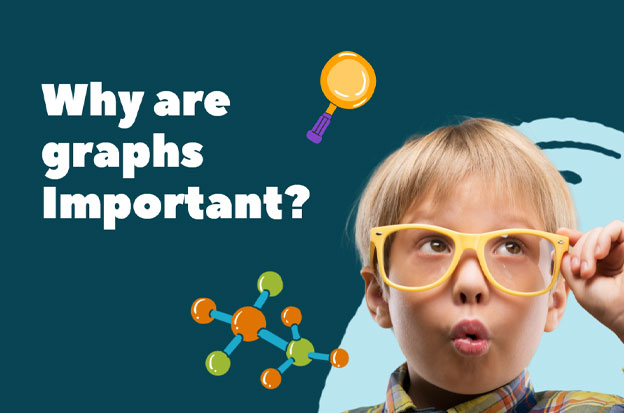
Why are graphs important?
If you are one of those people who don’t like math, there’s a good chance that you feel the same way about graphs, too. They involve numerical data, which makes them a struggle to deal with. There was a fun line in a movie from the 80s where Kim Basinger a visiting alien, cites “graphs” as her hobby.
However, the frequency of graphs used in everyday life is important, from spreading diseases to understanding links between the atoms in molecules. So instead of just relying on a graph maker, you should also have an answer to this question: Why are graphs important? Let’s run through the importance and uses of graphs in this article.
Business

Visual presentation of data makes it easier to understand large amounts of data, trends, and relationships.
The use of graphs in daily life also helps in making an analysis. For example, it provides structure in assessing performances, sales, and even deadlines. Seeing things visually helps you make quicker decisions.
Graphs also help make calculations easier. Whether you’re a sales assistant or a manager, you’ll find them helpful in understanding your sales figure. In addition, you can use them to identify which targets aren’t met and what you can do to correct your mistakes.
Home
Graphs aren’t just useful for people who do business and deal with numbers. Even people at home benefit from them.
Homeowners, for example, use graphs to plan their monthly budgets. First, they can create a graph projecting their expected expenses and savings. Then, when they fail to hit their targets, they can check their graphs to reassess their strategies.
Health Care
These days, big companies rely on graph databases to hold onto decades of health data and relay them to researchers, hospitals, caregivers, and patients. And as they share data, they can analyze them and their effects on society.
Graph databases help revolutionize research and even the treatment of deadly diseases. As a result, patients can receive the most effective drugs at the soonest possible time.
Additionally, graphs remain the most practical and efficient way to relay a vast amount of information. This goes particularly true with comparative numbers and information.
Visual presentations make it easy to create points that are hard to explain through words.
Online Dating

Believe it or not, even online dating benefits from graphs. In fact, a considerable number of dating sites, particularly the largest ones, have shifted to the use of graph databases in the last couple of months.
At first, it appeared odd. However, as experts notice how graphs are helping people find potential mates, their use has increased tremendously.
Graph databases don’t just store information about individuals, but they can also store their relationships. With this capability, expressing sophisticated questions and getting answers in just a short amount of time becomes possible. The process is even better than the traditional database.
You’ll also notice that graphs and data analytics are shared with audiences, as this proves to effectively convince them that their sites work. But, of course, it needs to look attractive, so they resort to pre-made templates, such as the ones found on Venngage.
Security
Fraud is a huge problem for insurance companies and banks, and it’s getting more and more common.
Traditional analysis techniques are used to be effective in catching fraud scenarios. However, investigators are now turning to graphs and graph databases to uncover different behavioral patterns as cases get more awful. Through them, they can catch not just individual fraudsters but fraud rings in real-time.
Recommendation engines
The real-time recommendations you get online are also a product of graph use. Amazon is one good example. Just look at its “You may also like…” feature.
After them, several enterprises followed. They started providing real-time suggestions to their online consumers through recommendation engines. They are generally powered by graph databases that enable companies to suggest personalized content, services, and products.
The same is true with Walmart. The business giant handles over 250 million customers each week. With graphs and graph databases, it’s able to connect buyers and products to better understand their customers’ needs and product trends. Everything happens in real-time, which makes it even more interesting.
Entertainment
The importance of graphs doesn’t just end with the above. Data visualization is also helpful to people working in the entertainment industry. They can measure TV ratings, assess viewers’ responses, and check other vital data through it.
AC Nielsen is a good example. It’s a research company that measured TV ratings before. It started an analysis process by creating a sample audience and questioning the selected audience to participate. The participants were randomly chosen at that time.
They used a black box to monitor what participants watched. Their data was sent to the company for analysis and storage. Then, the stored data was shared with different TV networks. Data gathered before were just based on estimations and were never completely accurate.
These days, people have streaming services. They are programmed with algorithms that understand viewers’ behaviors a couple of times better and faster. As a result, organizations can sort through their shows and pick what they can keep and what they need to remove through the data gathered. They can also figure out what kind of content their viewers are interested in.
My Stepmother is an Alien dialogue excerpt below:
Don’t you ever do stuff like go on vacation?
Sure we do.
What do you do on vacation?
Math.
What do you do to have fun?
Graphs.



Comments
Patience Ugwu
I love the way it broadly defines graph in some of our daily deeds.